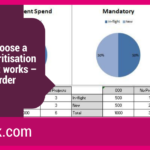Assigning priority to the projects within your project management process (PMO) will ensure that you use your limited resources wisely. When looking at choosing a project prioritisation process, Analytical Hierarchy Process (AHP) is useful when you work in a mature PMO.
Reworking your current project prioritisation process to start AHP can take some time and investment of resources, but it can boost your decision making. It’s a process that was developed in the 1970s and has become a trusted analytical method for prioritisation as well as other fields.
Whilst we’ve looked at the simple rank order prioritisation process and weighted scoring for your projects, they may be too rudimentary for your needs. To that end, we’re going to look at:
- What exactly the analytical hierarchy process is in terms of project prioritisation
- How you can introduce AHP to your PMO’s prioritisation process
- The pros and cons of AHP for project prioritisation
What is AHP when applied to PMO project prioritisation?
AHP is a process that turns subjective ideas and opinions and uses a mathematical model to turn them into data and numbers.
It was first developed in the 1970s as a way to bring data and analysis to decision making, rather than being based on the opinion of a leader.
You may have already come across AHP during your studies or when completing training or certificates during your PMO career. It can be applied to a range of actions and is useful to complete a detailed analysis of the priority of your projects.
Using AHP does require statistical analysis. You’ll likely need to program an Excel sheet to complete the processes, and there are some software tools that are available as well.
How do I implement AHP into my PMO’s prioritisation process?
Bringing AHP into your PMO may take a little more time and work than the other two project prioritisation models we’ve looked at. The basic process will look something like this:
- As with weighted scoring, you need to come up with a list of criteria that you’ll score projects against. These can be the same as weighted scoring if you currently use it, or you can reassess your needs.
- Weight the criteria for their importance; some businesses will put a lot of focus on customer outcomes, whereas other will be more geared towards strategic alignment, for example.
- Score the projects using the Likert scale, assigning each criterion a score from 1-5
- Using your software, a comparison will be made on the inputs into your database or software.
- Test the validity of the AHP prioritisation process against your finished projects to understand if it matches your needs and adjust your criteria and weightings if necessary.
The outcomes of an AHP analysis will be presented numerically, usually up to two decimal places. The higher the number, the higher the project priority.
What are the advantages and disadvantages of prioritising using AHP?
Pros of using AHP for project prioritisation
- The outputs you get will be specific and you can be sure it’s based in detailed analysis.
- It works well for PMOs that have a lot of projects in their portfolio because it takes into account a lot of information.
- You’re creating a repeatable process that can be run often and give similar outcomes.
- AHP is a well-respected process for making business decisions so there should be no issue with getting sponsor and C-suite buy-in to the new process.
Cons of using AHP for project prioritisation
Due to the mathematical calculations used, the more criteria you plug into AHP, the lower the maximum weight of each criterion can be, limiting your ability to give serious weight to very important criteria.
It’s a very technical process to set up, and some of the answers you need to assign a value may require data collection and analysis of their own.
There will be a demand on your resources, both in terms of the people you need to work through the process as well as creating or bringing in the tools to make it function.
The take-home
When you want to improve your PMO processes, choosing a project prioritisation process such as Analytical Hierarchy Process can be a step up in your work.
Whilst it is a technical process, it’s able to support a busy and growing PMO into the future.






